PHEDRA (Arc-jet) high enthalpy wind tunnel
The PHEDRA High Enthalpy low density Wind Tunnel, located at the ICARE[1] Laboratory in Orléans, France, is a research facility used extensively for fundamental and applied research on non equilibrium plasma flows and planetary atmospheric entries. Its name is an acronym for soufflerie à Plasma Hors Equilibre de Rentreés Atmosphériques . Phedra wind tunnel takes part of the European Landscape Network portal MERIL.[2]
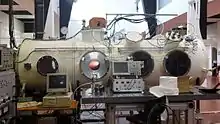
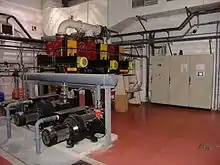
History
PHEDRA (ex. SR5) wind tunnel was located in the Aerothermodynamics Laboratory from the CNRS (France's national scientific research center) in Meudon, France until 2000. The wind tunnel was then moved to the ICARE Laboratory in Orleans, resulting from the merging of the Aerothermodynamics Laboratory and the LCSR (Combustion and Reactive Systems Laboratory). This facility is part of the experimental plateform FAST (Facilities for Aerothermodynamics & Supersonic Technologies, contact Viviana Lago head of FAST team, [email protected]) belonging in ICARE Institut from CNRS, Orléans.
Technical details
PHEDRA is a plasma ground test facility used to simulate low pressure flight conditions in the upper layer of the planetary atmospheres. An arc-jet generator operates in a cylindrical chamber of 1;1 m in diameter and 4.3 m length, pumped with 3 primary pumps and 3 Roots pumps, which capacity (27 000 m3/h) insures a residual pressure ranged between 1 and 100 Pa. Different working gases can be used like Argon, nitrogen, CO2, CH4 Air, allowing the simulation of several planetary entry conditions like earth (80%N2-20%O2), Mars (97%CO2-3%N2) or Titan (99% N2-1% CH4). The advantages of the home-made designed plasma source can be found in the stability of the plasma flow, the high specific enthalpy, up to 50 MJ/kg due to the low mass flow rate and the low rate of contamination which could provides from the erosion of the cathode.
Main features
- Continuous supersonic high enthalpy rarefied wind tunnel.
- 4.5m x 2.1 m test chamber
- Nozzle: conical
- Adjustable pumping group, max capacity: 26 000 m3/h
- Static pressure, Pa: 1 < Pstg < 3000
- Stagnation pressure, Pa: 20 < Po < 120 105
- Mach number: 2 < Mach < 8
- Averaged enthalpy, Mj/kg few < Ho < 50
- Working gas: N2, Air, CO2, CH4, Ar and extensive mixtures
Instrumentation
Various types of diagnostics are associated to the wind tunnel PHEDRA: Pitot Probes, Pressure sensors for parietal measurements, Heat transfer gauges, Infrared thermography camera, iCCD camera, Electrostatic probes, Optical spectrometry (near IR, visible and VUV). They are employed for fundamental and applied studies in the fields of Compressible Aerodynamics, Aerothermodynamics, Atmospheric entries and Gas and Plasma Physics.
Purpose & use
The wind tunnel PHEDRA is extensively used for fundamental and applied research applied to planetary atmospheric entry Some works undertaken with this facility are listed here:
- Fundamental research of high enthalpy fluid dynamic phenomena in non-equilibrium flows
- Plasma dynamics
- Experimental data base on planetary atmospheric entries : MARS, EARTH, TITAN, VENUS
- Aerodynamic and aerothermal behavior of probes and models
- Plasma flow control with MHD.
- Atmospheric entry space debris
Gallery
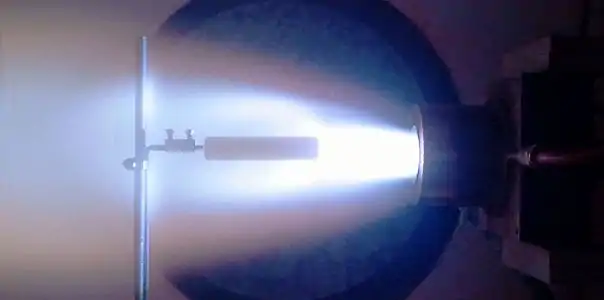 Blunt cylinder in a low pressure supersonic argon plasma flow in the Phedra facility.Phedra facility, ICARE, CNRS (Viviana Lago).
Blunt cylinder in a low pressure supersonic argon plasma flow in the Phedra facility.Phedra facility, ICARE, CNRS (Viviana Lago).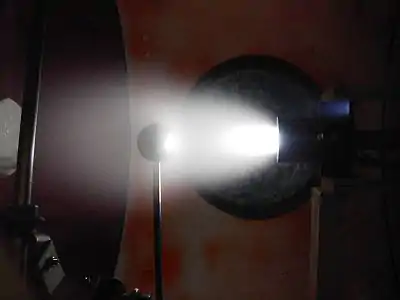 Spheric model interacting with CO2/N2 'Mars' like plasma low pressure supersonic flow. Phedra facility, ICARE, CNRS (Viviana Lago).
Spheric model interacting with CO2/N2 'Mars' like plasma low pressure supersonic flow. Phedra facility, ICARE, CNRS (Viviana Lago).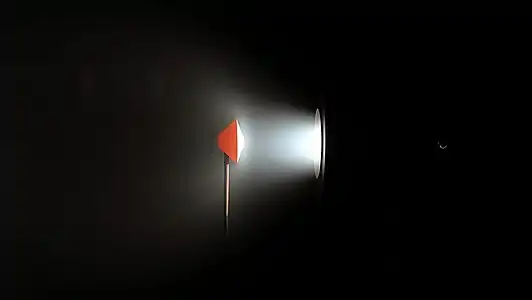 Capsule model interacting with CO2/N2 'Mars' like plasma low pressure supersonic flow. Phedra facility, ICARE, CNRS Viviana Lago).
Capsule model interacting with CO2/N2 'Mars' like plasma low pressure supersonic flow. Phedra facility, ICARE, CNRS Viviana Lago).
References
- ICARE Laboratory, CNRS, Orléans
- MERIL, the european facilities platform
- Ndiaye, Abdoul; Lago, Viviana (2011). "Optical spectroscopy investigation of N2–CH4 plasma jets simulating Titan atmospheric entry conditions". Plasma Sources Science and Technology. 20 (1): 015015. doi:10.1088/0963-0252/20/1/015015.
- Lago, Viviana (2006). "Electron and vibrational temperatures in hypersonic CO2–N2 plasma jets". Plasma Sources Science and Technology. 16 (1): 139–148. doi:10.1088/0963-0252/16/1/019.
- Lago, Viviana (2012). "Experimental investigation of supersonic plasmas flow fields modification by magnetic fields". 18th AIAA/3AF International Space Planes and Hypersonic Systems and Technologies Conference. AIAA: 5869. doi:10.2514/6.2012-5869. ISBN 978-1-60086-931-0.
- Lago, Viviana (2015). "Radiation Measurements in Low Pressure High Enthalpy Flows from VUV to near IR region". 20th AIAA International Space Planes and Hypersonic Systems and Technologies Conference. AIAA. doi:10.2514/6.2015-3516. ISBN 978-1-62410-320-9.
- Joussot, Romain; Coumar, Sandra; Lago, Viviana (2015). "Plasmas for High Speed Flow Control". AerospaceLab. ONERA (10). doi:10.12762/2015.AL10-04.